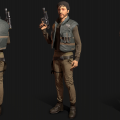-
Posts
439 -
Joined
-
Last visited
Content Type
News Articles
Tutorials
Forums
Downloads
Everything posted by SomaZ
-
@@Archangel35757 https://github.com/DT85/OpenDF2/tree/rend2-sp I guess.
-
Looks like you are right. My brain played a trick on me. Could have sworn I had seen a tutorial, where someone scaled up a base jka map with a misc_bsp enitity. Very odd. o.O
-
The misc_bsp is the space map. You scale the map instead of everything else, which should be better in the first place. Though I noticed that you might not be able to use a large scaled map that exceeds the normal limitations. But it's worth a try.
-
There is a way right now for doing it without changing the code in any way. You need two maps. First one is the main map that stores all the information that is important. The second one is simply a map with a misc_bsp entity with a scale. Model would be the first map, scale anything you want it to be. You'll only loose some precision for model lighting, since you also scale the lightgrid from the first map.
-
Ah, rend2 has its own tangent space calculations. Thought on adding mikkt-space, but for now you simply cant get the right tangents and bi-tangents, sry
-

The One Brush To Screw Them All, And Then The Gtk Hates Them! Xd
SomaZ replied to AngelModder's topic in Modding Assistance
What about breaking up the map in multiple parts and use misc_bsp entities? -
I already did with the cubemap convolution code, but it only works on the rend2 weather branch (simply because I did a port of this branch and it changed alot, so I didn't want to backport my code), which renders rain on every map, all the time. Every part of the code of DF2 is public. You simply have to search it on GitHub....
-
For this you need to understand how normal mapping actually works. It fakes the normal direction of the surface and darkens the areas that point kind of the same direction as the light. Problem with that is, that you have to know where the light is, to compair the normal vector and the light incident vector. The real problem in this case is that all the surfaces lit by static lights only store the information of how much light there is and which color shines on it. This information is stored in the .bsp as a lightmap (actually several ones). You have no information about the incident light vector. This results in normal mapping that is only visible with (real) dynamic lights like saber and muzzleflashes. You have multiple options. First one: Tell the shader before compilation that there is a normal map and bake the occlusion information in the lightmaps. Pro: Easy to work out, you find a tutorial in the tutorials section about it. Con: You actually loose the advantage of very crisp normal mapping for static lights, because lightmaps have a low resolution. (you could krank it up in GTKRadiant, but you will loose lots of performance overall) Second one: Use fxRunners. There was a map Scizo made for rend2 and he added dynamic ligths via fxRunners. I have no idea how this works, I guess you can find the map 2 or 3 pages prior this one. He included his map file (also all his shaders, textures and so on, so this is worth a look for you). Third one: Use parallax mapping. Example also in the map made by Scizo. Last one (not a real one I guess): Fix deluxe mapping in the rend2 branch and simply compile your map with -deluxe in the lighting stage. (this technique is not perfect, but it should suffice for most cases) GL2 can use deluxemapping, ioq3 too. Hope this helps.
-
Got some more time to work on it. Structural models are complete now. Now I need to fake some moving light shafts comming through the water and make some proper lava river beneath the windows. Maybe also add some particle effects like some smoke from the lava stream.
-
Because there are lots of devs that can not be contacted anymore. They simply vanished. I know this is BS and trust me, I'd love to see how much further the community could push this, but it won't happen. Please simply accept this and let it be. They tried to find everyone over a year without success. You won't change this, nor anyone else.
-
We had no saber-combat back in the days, some unfinished classes and lots of unfinished maps. Imo Gameplay didn't feel like jka either. Still would have been awesome to release this pretty piece of a mod. (It's not possible though, there were several attempts) It was super fun to play every Saturday evening with all the other devs. Miss these days.
-
Well, I got a new patch from ioq3 working in our GL2 renderer. I needed to change few more things to make it work, but it does now. This enables cg_shadows 3 to work again. I know this is not really what we want, but:
-
- 20 comments
-
- Star Wars Related
- NPC Support
-
(and 3 more)
Tagged with:
-
https://www.youtube.com/watch?v=QHRuTYtSbJQ
-
Ok guys, I wrote a bit with the original creator of the water shading and asked him about the permission to use it for gl2. We got it. Means I will polish the code a bit and add a water plane to the balls map. It's highly customizable and procedually generated. I want to add some cvars to change the parameters in real time to get some fast results without starting the game over and over again. Well, we could make some kind of challenge and ask the people to find nice values for it. Maybe different kind of fluids. Idk, get the people to fool around in our mod and feel to be part of the development.
-
Hahaha, ok, balls map it will be. Now only things left are asking scerendo for his permission and packing everything. I'll upload the kit here in the thread first, to make sure everyone is fine with the release.
-
@@minilogoguy18 Purpose of the mod kit is not to show of our mod or our progress, but more to give people some kind of sandbox to fool around and make them aware of the possibilities working with our mod. I think this is a good way to get some people attracted without publishing anything from our mod. @@Circa ModDB is a very good place to get some attention though I feel like the overall interest in ModDB has decreased. @@DT85 Which map do you mean? The one with the floating red balls or my shelter map? I have no idea who did the floating balls map, so no idea who I should ask for permission. I should polish my shelter map for a release anyways. What about the bryar? Can I put the current version with animations in the kit?
-
Hey guys, I had an idea. I'd like to upload some kind of mod kit here on the hub, including one pbr textured playermodel (I would ask Scerendo for his Aayla), one pbr textured weapon (@@AshuraDX?), one pbr textured test map (thought about @@DT85 's test map, maybe with the substance spheres added) and a new build of the mod. Everything ready to play around and learn how all the stuff works together. Maybe we can get some more attention with this. What do you guys think?
-
Looks like you want to use rend2 with a newer build of OpenJK. The rendering API changed afaik. You can currently only use rend2 with the latest build before that change. I have no idea which build this happened. Maybe @@ensiform knows more? Else you can simply compile the latest code of Xyc's rend2 repro. Wait, are you trying to use rend2 with the vanilla jamp?
-
Yea, thats a thing for rendering, I also thought about it. As I said in the description of the video, this is a very early wip and I'm not sure if I scrap it completely and write a complete new water shader.
-
I started to work on a water shader. It's kind of a port of one shader from shadertoy. I'm not sure if I keep it. Still, here is a video: https://www.youtube.com/watch?v=y-Rh-VXN9ww Update:
-

Application as a Level Object Artist - ACCEPTED
SomaZ replied to Nupol's topic in Dark Forces II Mod
Nevertheless: You have my sword! (Obviously ) -

Application as a Level Object Artist - ACCEPTED
SomaZ replied to Nupol's topic in Dark Forces II Mod
@@DT85 Just look at the top of his no name soda can. -
Well, I found some time to work on this again. This time rendered in GL2. Pictures: Video: Lighting on the pillars is fucked up, this is subject to change when I have some more spare free time.




